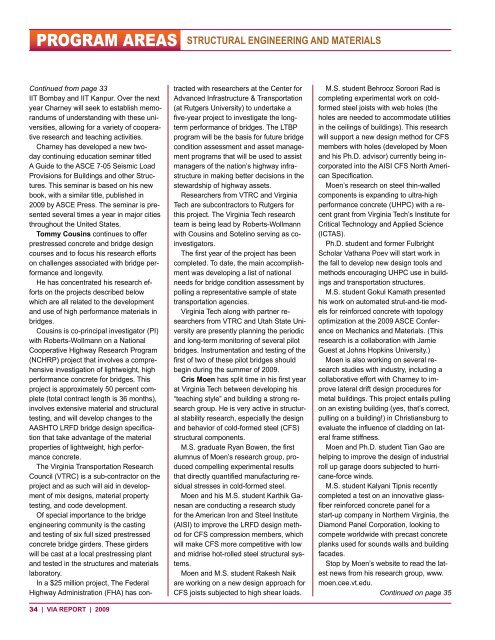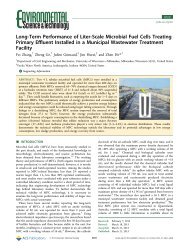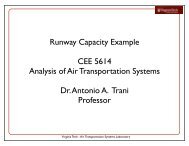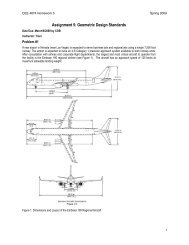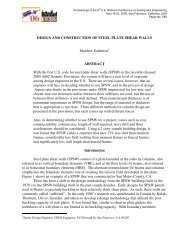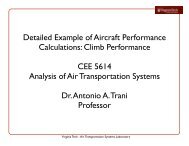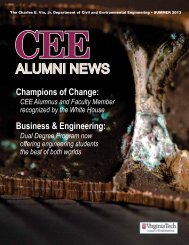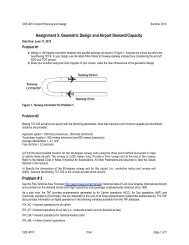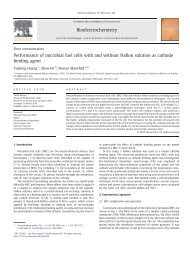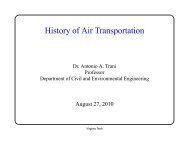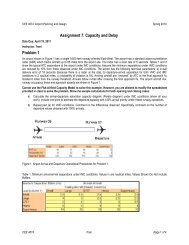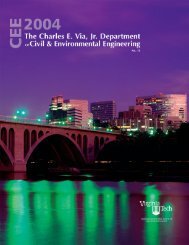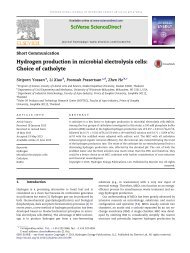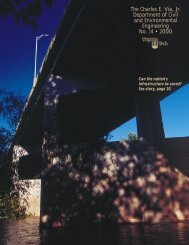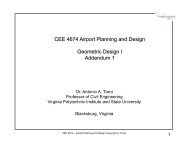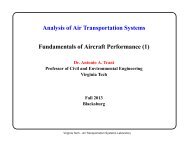Annual Report Year 2009 - Civil and Environmental Engineering
Annual Report Year 2009 - Civil and Environmental Engineering
Annual Report Year 2009 - Civil and Environmental Engineering
- No tags were found...
Create successful ePaper yourself
Turn your PDF publications into a flip-book with our unique Google optimized e-Paper software.
PROGRAM AREAS<br />
STRUCTURAL ENGINEERING AND MATERIALS<br />
Continued from page 33<br />
IIT Bombay <strong>and</strong> IIT Kanpur. Over the next<br />
year Charney will seek to establish memor<strong>and</strong>ums<br />
of underst<strong>and</strong>ing with these universities,<br />
allowing for a variety of cooperative<br />
research <strong>and</strong> teaching activities.<br />
Charney has developed a new twoday<br />
continuing education seminar titled<br />
A Guide to the ASCE 7-05 Seismic Load<br />
Provisions for Buildings <strong>and</strong> other Structures.<br />
This seminar is based on his new<br />
book, with a similar title, published in<br />
<strong>2009</strong> by ASCE Press. The seminar is presented<br />
several times a year in major cities<br />
throughout the United States.<br />
Tommy Cousins continues to offer<br />
prestressed concrete <strong>and</strong> bridge design<br />
courses <strong>and</strong> to focus his research efforts<br />
on challenges associated with bridge performance<br />
<strong>and</strong> longevity.<br />
He has concentrated his research efforts<br />
on the projects described below<br />
which are all related to the development<br />
<strong>and</strong> use of high performance materials in<br />
bridges.<br />
Cousins is co-principal investigator (PI)<br />
with Roberts-Wollmann on a National<br />
Cooperative Highway Research Program<br />
(NCHRP) project that involves a comprehensive<br />
investigation of lightweight, high<br />
performance concrete for bridges. This<br />
project is approximately 50 percent complete<br />
(total contract length is 36 months),<br />
involves extensive material <strong>and</strong> structural<br />
testing, <strong>and</strong> will develop changes to the<br />
AASHTO LRFD bridge design specification<br />
that take advantage of the material<br />
properties of lightweight, high performance<br />
concrete.<br />
The Virginia Transportation Research<br />
Council (VTRC) is a sub-contractor on the<br />
project <strong>and</strong> as such will aid in development<br />
of mix designs, material property<br />
testing, <strong>and</strong> code development.<br />
Of special importance to the bridge<br />
engineering community is the casting<br />
<strong>and</strong> testing of six full sized prestressed<br />
concrete bridge girders. These girders<br />
will be cast at a local prestressing plant<br />
<strong>and</strong> tested in the structures <strong>and</strong> materials<br />
laboratory.<br />
In a $25 million project, The Federal<br />
Highway Administration (FHA) has con-<br />
34 | VIA REPORT | <strong>2009</strong><br />
tracted with researchers at the Center for<br />
Advanced Infrastructure & Transportation<br />
(at Rutgers University) to undertake a<br />
five-year project to investigate the longterm<br />
performance of bridges. The LTBP<br />
program will be the basis for future bridge<br />
condition assessment <strong>and</strong> asset management<br />
programs that will be used to assist<br />
managers of the nation’s highway infrastructure<br />
in making better decisions in the<br />
stewardship of highway assets.<br />
Researchers from VTRC <strong>and</strong> Virginia<br />
Tech are subcontractors to Rutgers for<br />
this project. The Virginia Tech research<br />
team is being lead by Roberts-Wollmann<br />
with Cousins <strong>and</strong> Sotelino serving as coinvestigators.<br />
The first year of the project has been<br />
completed. To date, the main accomplishment<br />
was developing a list of national<br />
needs for bridge condition assessment by<br />
polling a representative sample of state<br />
transportation agencies.<br />
Virginia Tech along with partner researchers<br />
from VTRC <strong>and</strong> Utah State University<br />
are presently planning the periodic<br />
<strong>and</strong> long-term monitoring of several pilot<br />
bridges. Instrumentation <strong>and</strong> testing of the<br />
first of two of these pilot bridges should<br />
begin during the summer of <strong>2009</strong>.<br />
Cris Moen has split time in his first year<br />
at Virginia Tech between developing his<br />
“teaching style” <strong>and</strong> building a strong research<br />
group. He is very active in structural<br />
stability research, especially the design<br />
<strong>and</strong> behavior of cold-formed steel (CFS)<br />
structural components.<br />
M.S. graduate Ryan Bowen, the first<br />
alumnus of Moen’s research group, produced<br />
compelling experimental results<br />
that directly quantified manufacturing residual<br />
stresses in cold-formed steel.<br />
Moen <strong>and</strong> his M.S. student Karthik Ganesan<br />
are conducting a research study<br />
for the American Iron <strong>and</strong> Steel Institute<br />
(AISI) to improve the LRFD design method<br />
for CFS compression members, which<br />
will make CFS more competitive with low<br />
<strong>and</strong> midrise hot-rolled steel structural systems.<br />
Moen <strong>and</strong> M.S. student Rakesh Naik<br />
are working on a new design approach for<br />
CFS joists subjected to high shear loads.<br />
M.S. student Behrooz Soroori Rad is<br />
completing experimental work on coldformed<br />
steel joists with web holes (the<br />
holes are needed to accommodate utilities<br />
in the ceilings of buildings). This research<br />
will support a new design method for CFS<br />
members with holes (developed by Moen<br />
<strong>and</strong> his Ph.D. advisor) currently being incorporated<br />
into the AISI CFS North American<br />
Specification.<br />
Moen’s research on steel thin-walled<br />
components is exp<strong>and</strong>ing to ultra-high<br />
performance concrete (UHPC) with a recent<br />
grant from Virginia Tech’s Institute for<br />
Critical Technology <strong>and</strong> Applied Science<br />
(ICTAS).<br />
Ph.D. student <strong>and</strong> former Fulbright<br />
Scholar Vathana Poev will start work in<br />
the fall to develop new design tools <strong>and</strong><br />
methods encouraging UHPC use in buildings<br />
<strong>and</strong> transportation structures.<br />
M.S. student Gokul Kamath presented<br />
his work on automated strut-<strong>and</strong>-tie models<br />
for reinforced concrete with topology<br />
optimization at the <strong>2009</strong> ASCE Conference<br />
on Mechanics <strong>and</strong> Materials. (This<br />
research is a collaboration with Jamie<br />
Guest at Johns Hopkins University.)<br />
Moen is also working on several research<br />
studies with industry, including a<br />
collaborative effort with Charney to improve<br />
lateral drift design procedures for<br />
metal buildings. This project entails pulling<br />
on an existing building (yes, that’s correct,<br />
pulling on a building!) in Christiansburg to<br />
evaluate the influence of cladding on lateral<br />
frame stiffness.<br />
Moen <strong>and</strong> Ph.D. student Tian Gao are<br />
helping to improve the design of industrial<br />
roll up garage doors subjected to hurricane-force<br />
winds.<br />
M.S. student Kalyani Tipnis recently<br />
completed a test on an innovative glassfiber<br />
reinforced concrete panel for a<br />
start-up company in Northern Virginia, the<br />
Diamond Panel Corporation, looking to<br />
compete worldwide with precast concrete<br />
planks used for sounds walls <strong>and</strong> building<br />
facades.<br />
Stop by Moen’s website to read the latest<br />
news from his research group, www.<br />
moen.cee.vt.edu.<br />
Continued on page 35


